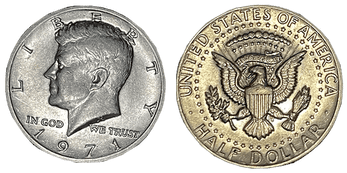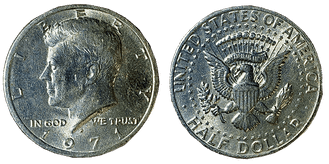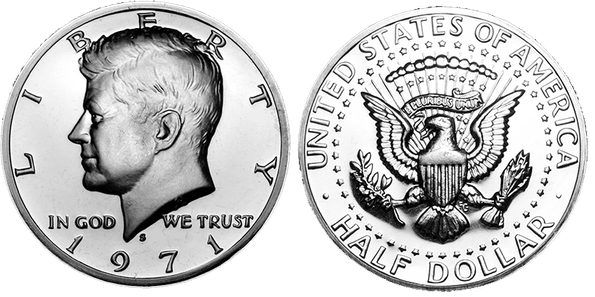
Dr. Evelyn Reed
About the Author
Dr. Evelyn Reed pursued her intellectual curiosity with rigor, earning a Ph.D. in Economic History from the esteemed University of Cambridge.
Her comprehensive doctoral research delved into the nuanced evolution of currency throughout the significant transformations of the 20th century. This intensive study provided her with an exceptionally deep understanding of the historical and economic significance, prompting her to investigate questions like what makes a 1971 Kennedy half dollar rare.
This naturally led her to explore the half dollar coin value 1971 and determine how much is a 1971 half dollar worth. She meticulously cataloged each piece, including those with a 1971 D half dollar value and those with a 1971 half dollar no mint mark, carefully noting any variations that might affect the 1971 half dollar value no mint mark. For Dr. Reed, even the seemingly common 1971 JFK half dollar value held historical weight.
Factors Affecting Value
- Condition: As with all coins, the condition of a 1971 50C is a primary factor in determining its Kennedy 1971 half dollar value. Uncirculated coins with original luster are worth significantly more than worn, circulated examples. Grading services provide standardized assessments of a coin’s condition, directly impacting the half dollar 1971 valor actual and the half dollar 1971 precio.
- Mint Mark: The presence and location of the mint mark (“D” for Denver, “S” for San Francisco, no mint mark for Philadelphia) help identify the coin’s origin and type (business strike or proof), which affects its value of a 1971 Kennedy half dollar.
- Rarity: While the mintage numbers for 1971 50 cents are relatively high, uncirculated examples in high grades and proof coins are scarcer and thus more valuable, influencing the overall Kennedy half 1971 half dollar value.
- Errors: Coins with minting errors from 1971 can also attract significant premiums from collectors, further contributing to the potential value of a 1971 Kennedy half dollar.
Unlocking the Value of 1971 Half Dollar Coins: A Collector’s Guide
1971 No Mint Mark 50C Value

| Name | 1971 Philadelphia Half Dollar |
| Mint | Philadelphia |
| Composition | 40% silver, 60% copper |
| Mintage | 155,484,000 |
| Price (USD) | $1.50 – $5+ (in circulated condition) |
Listed prices are approximate and may vary depending on the coin’s condition, market demand, and other factors.
Historical Context of the 1971 No Mint Mark 50C
The 1971 half dollar, bearing no mint mark, stands as a tangible product of the esteemed Philadelphia Mint. This particular year, 1971, marked a pivotal juncture in the composition of United States coinage.
However, in 1971, a strategic shift occurred, transitioning to a copper-nickel clad composition that incorporated 40% silver, directly impacting the 1971 half dollar silver content.
This seemingly small detail, the lack of a mint mark, becomes a crucial element for discerning collectors diligently seeking to understand the 1971 half dollar value no mint mark and to accurately distinguish these Philadelphia-produced coins, also known as the 1971 Kennedy half dollar no mint mark, from those originating elsewhere. This is often referenced in a 1971 Kennedy half dollar value chart.
The deliberate decision to strategically reduce the silver content within the 50 cent was a direct response to the volatile and steadily rising prices of silver on the global market, significantly influencing the value of 1971 half dollar and the overall 1971 half dollar coin value. This proactive measure aimed to conserve this precious and increasingly valuable metal for essential industrial and strategic applications, reflecting a broader economic awareness.
The venerable Philadelphia Mint, with its rich heritage, played an undeniably central role in navigating this significant transition. It undertook the monumental task of producing a substantial quantity of 50 cents, ensuring the smooth functioning of commerce during this period of change, alongside the production of the 1971 Kennedy half dollar D at the Denver Mint.
Production and Specifications
The 1971 50C emanating from the Philadelphia Mint were meticulously crafted with a specific metallic composition: 40% fine silver and 60% copper.This transitional composition directly influences the value of 1971 Kennedy half dollar.
These coins possess a tangible weight of 11.34 grams and a precise diameter of 30.61 millimeters, further distinguished by their characteristic reeded edge, a security feature common to many denominations.
This distinction is a key consideration for collectors and investors alike when consulting a value chart 1971 half dollar value to determine what is a 1971 Kennedy half dollar worth and, more broadly, what is a 1971 half dollar worth, ultimately affecting the overall Kennedy half dollar value 1971.
Market Value
| Condition | Estimated Value |
| Circulated | $1.50 – $5+ |
| Uncirculated (MS63) | $8 – $20 |
| Uncirculated (MS65) | $25 – $60 |
| Uncirculated (MS66) | $70 – $150+ |
The value of circulated 1971 Philadelphia 50 cents is typically above their face value due to their 40% silver content. Uncirculated coins in higher grades can be significantly more valuable to collectors.
Identifying a Philadelphia Half Dollar
To confidently identify a 1971 50 cents lacking a mint mark as a product of the Philadelphia Mint, meticulous attention should be paid to the following key distinguishing features:
- Unequivocal Absence of a Mint Mark: The most immediate and crucial identifier is the complete absence of any letter mint mark on either the obverse (the front of the coin) or the reverse (the back of the coin). This deliberate omission of a mint mark serves as the definitive hallmark indicating its origin at the Philadelphia Mint during this specific period.
- Iconic Design Elements: The 1971 50C proudly features the distinguished left-facing profile of President John F. Kennedy on the obverse. Encircling this central portrait are the enduring inscriptions “LIBERTY,” a testament to American freedom; “IN GOD WE TRUST,” the national motto; and the prominent date “1971,” marking the year of its minting. The reverse of the coin showcases the majestic Presidential Seal, an emblem of the executive branch of the United States government.
- Precise Physical Attributes: The 1971 half dollar adheres to specific and standardized physical dimensions. It should possess a tangible weight of 11.34 grams and a precise diameter of 30.61 millimeters. Furthermore, the coin’s edge should exhibit a reeded texture, characterized by a series of parallel vertical grooves. These precise physical specifications serve as critical indicators of authenticity and are particularly important in distinguishing these 40% silver coins from later 50 cents crafted with a non-silver clad composition.
1971 D 50C Value

| Name | 1971 D Denver Half Dollar |
| Mint | Denver |
| Composition | 40% silver, 60% copper |
| Mintage | 189,287,630 |
| Price (USD) | $1.50 – $5+ (in circulated condition) |
Listed prices are approximate and may vary depending on the coin’s condition, market demand, and other factors.
Historical Context of the 1971 D Half Dollar
The esteemed Denver Mint also played a pivotal and substantial role in the production of the 40% silver half dollars during the significant year of 1971. These coins, readily identified by the presence of the distinct “D” mint mark, were instrumental in fulfilling the nation’s considerable demand for circulating coinage during this period of transition in the metallic composition of United States currency.
This raises the question of how to tell if a 1971 half dollar is silver, as only those produced before 1971 contained a significant amount of silver (40% in 1965-1970). The 1971 issues were the first without any silver for general circulation, making the term 1971 silver half dollar value somewhat of a misnomer for standard issues. It’s important to note that there was no 1971 liberty half dollar issued; the half dollar design featured Kennedy.
The Denver Mint, with its rich and storied history dating back to its establishment in 1906, has consistently served as a vital branch of the United States Mint system, responsible for producing a significant portion of the country’s circulating coins, including the 1971 D Kennedy half dollar value.
Collectors also look for 1971 Kennedy half dollar errors and any 1971 half dollar error that might increase their value. While most 1971 half dollars are common, certain errors can make them surprisingly valuable, answering the question of is a 1971 half dollar worth anything beyond its face value. The presence of the “D” mint mark on these 1971 half dollars serves as a clear and enduring historical indicator of their origin at this important minting facility located in the Rocky Mountain region.
Production and Specifications
The 1971 D half dollars, produced at the Denver Mint, adhere to the same standardized metallic composition as their counterparts minted in Philadelphia: 40% fine silver and 60% copper. This consistent composition across both major minting facilities during this specific year underscores the national uniformity adopted in response to the fluctuating silver market.
Furthermore, the physical dimensions of the 1971 D half dollars mirror those of the Philadelphia issues. They possess an identical weight of 11.34 grams and an equivalent diameter of 30.61 millimeters. This deliberate consistency in physical attributes ensured seamless integration into the existing system of commerce and coin-operated devices throughout the nation.
Market Value
| Condition | Estimated Value |
| Circulated | $1.50 – $5+ |
| Uncirculated (MS63) | $8 – $20 |
| Uncirculated (MS65) | $25 – $60 |
| Uncirculated (MS66) | $70 – $150+ |
Similar to the Philadelphia issues, circulated 1971 D half dollars are worth more than face value due to their silver content. Uncirculated examples command higher prices among collectors.
Identifying a Denver (D) Half Dollar
To accurately identify a 1971 half dollar originating from the Denver Mint, the key lies in locating the distinct “D” mint mark. This identifying mark is positioned on the obverse (front) of the coin, specifically below the portrait of President John F. Kennedy and to the left of the prominent date “1971.”
In addition to the crucial mint mark, the 1971 D half dollar shares the standard Kennedy half dollar design:
- Obverse: A distinguished left-facing profile of John F. Kennedy, accompanied by the inscriptions “LIBERTY,” “IN GOD WE TRUST,” the date “1971,” and the clearly visible “D” mint mark.
- Reverse: The iconic heraldic eagle, proudly displaying a shield on its chest and clutching arrows and an olive branch in its talons, along with the inscriptions “UNITED STATES OF AMERICA” and “HALF DOLLAR.”
Finally, to ensure authenticity, the 1971 D half dollar should conform to the standard physical specifications for a U.S. half dollar of that era: a weight of 11.34 grams and a diameter of 30.61 millimeters.
1971 S Proof 50C Value

| Name | 1971 S Proof Half Dollar |
| Mint | San Francisco |
| Composition | 40% silver, 60% copper |
| Mintage | 3,220,631 |
| Price (USD) | $5 – $15+ (depending on condition, higher for PR69/PR70) |
Listed prices are approximate and may vary depending on the coin’s condition, market demand, and other factors.
Historical Context of the 1971 S Proof Half Dollar
In the year 1971, the esteemed San Francisco Mint continued its established tradition of producing exquisite proof coinage, readily identifiable by the prominent “S” mint mark. These special proof 50 cents were meticulously crafted specifically for discerning collectors, showcasing a significantly elevated level of detail and a distinct, mirror-like finish that far surpasses the characteristics of standard circulating coins produced at the Philadelphia and Denver Mints.
The San Francisco Mint’s unwavering commitment to superior quality and its direct catering to the burgeoning community of coin collectors firmly establish these proof issues as distinct and generally more valuable than their business strike counterparts produced for general circulation.
Production and Specifications
The production process and the superior quality of the materials employed in their creation resulted in a significantly enhanced visual appeal and a higher value of 1971 half dollar for collectors. These factors are crucial when consulting a 1971 Kennedy half dollar value chart or determining how much is a half dollar from 1971 worth, especially for proof examples.
While the Kennedy half dollar 1971 value for standard circulating coins might be modest, proof versions, particularly those with notable 1971 half dollar value error instances or exceptional preservation, can command a premium. Despite having the same 1971 Kennedy half dollar silver content (40% in the outer layers) as the circulating coins from that year, the special handling and striking of these San Francisco proofs set them apart in terms of collector desirability and value.
While the fundamental metallic composition of these coins – a core of copper enveloped by an outer layer containing 40% silver – remained consistent with the circulating 1971 50C, and they adhered to the same standard physical dimensions (11.34 grams in weight and 30.61 millimeters in diameter), the specialized striking process and the superior quality of the materials employed in their production unequivocally set them apart, directly influencing the elevated value of a 1971 quarter proof.
Market Value
| Condition | Estimated Value |
| PR60-PR65 | $5 – $15 |
| PR66-PR69 | $15 – $40 |
| PR70 (Deep Cameo) | $50 – $120+ |
The 1971 S proof 50 cents are significantly more valuable than circulated business strike coins due to their collector appeal and higher quality. Coins graded in the higher proof states (PR69 and PR70) with a deep cameo effect command the highest prices.
Identifying the S Proof Half Dollar
To positively identify a 1971 S coin, look for the following distinctive characteristics:
- Prominent “S” Mint Mark: The most immediate and crucial identifier is the clear presence of the “S” mint mark, signifying its origin at the San Francisco Mint and its status as a proof coin. This “S” is typically located on the obverse of the coin, positioned below the portrait of President John F. Kennedy and to the left of the date “1971.” The presence of this specific mint mark is the primary differentiator when assessing the half dollar coin 1971 value compared to the Philadelphia issue (which lacks a mint mark) and the Denver issue (which bears a “D” mint mark), especially when considering potential for a 1971 D half dollar error.
- Distinctive Proof Finish: The most striking and readily apparent characteristic of a 1971 “S” half dollar, and a significant contributor to how much is a 1971 Kennedy half dollar worth for proof examples, is its brilliant, mirror-like surface across both the obverse and the reverse. This deep contrast and the exceptional sharpness of the design are the defining hallmarks of a proof coin and are critical factors when evaluating its numismatic worth and understanding what makes a 1971 Kennedy half dollar rare in such pristine condition.
- Standard Design Elements: The 1971 “S” proof half dollar features the same iconic design elements as its circulating counterparts: Obverse: The recognizable left-facing profile of President John F. Kennedy, accompanied by the inscriptions “LIBERTY,” “IN GOD WE TRUST,” and the date “1971,” along with the distinct “S” mint mark. Reverse: The familiar heraldic eagle design, featuring a shield and clutching arrows and an olive branch, along with the inscriptions “UNITED STATES OF AMERICA” and “HALF DOLLAR.”
When evaluating the half dollar coin 1971 value, consulting reputable coin dealers or professional grading services is recommended for an accurate appraisal, particularly if you suspect a 1971 D half dollar error or any other 1971 half dollar error.
In summary, when assessing the half dollar coin 1971 value, it is crucial to identify the mint mark (or lack thereof for Philadelphia), the condition of the coin, and whether it is a business strike or a proof issue from San Francisco.
The fact that all 1971 half 50C contain 40% silver adds intrinsic value, making them worth more than their face value. Proof examples, due to their superior quality and collector demand, typically command the highest prices, and any significant 1971 half dollar error can further increase their worth and contribute to what makes a 1971 Kennedy half dollar rare.